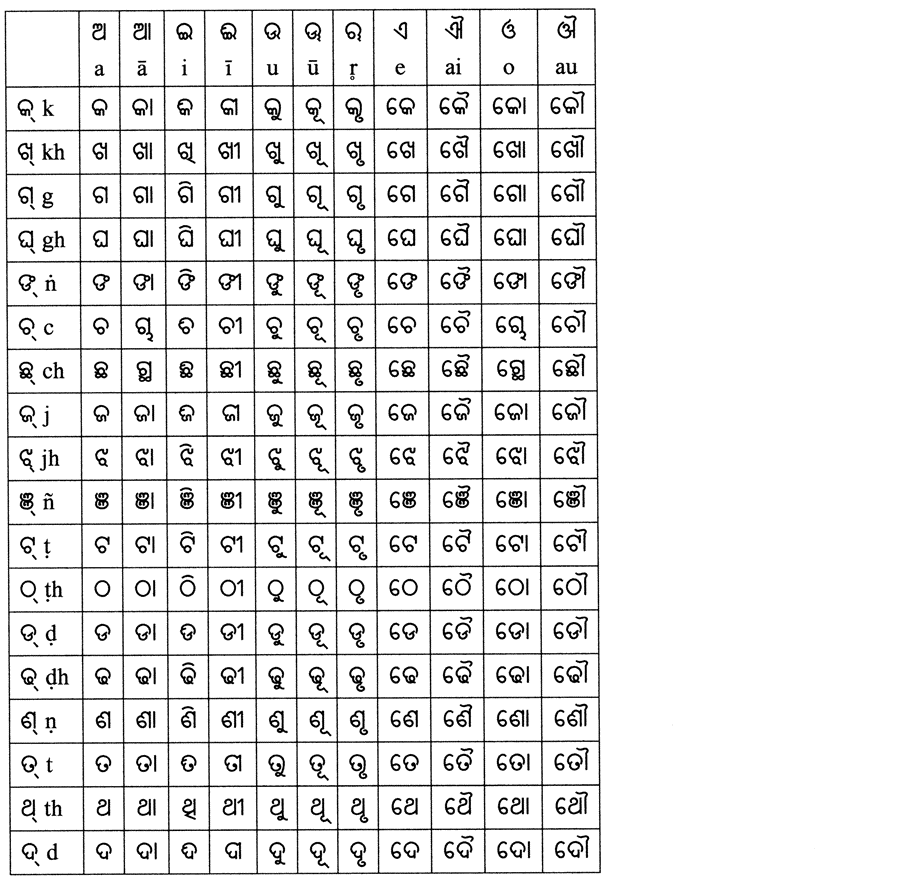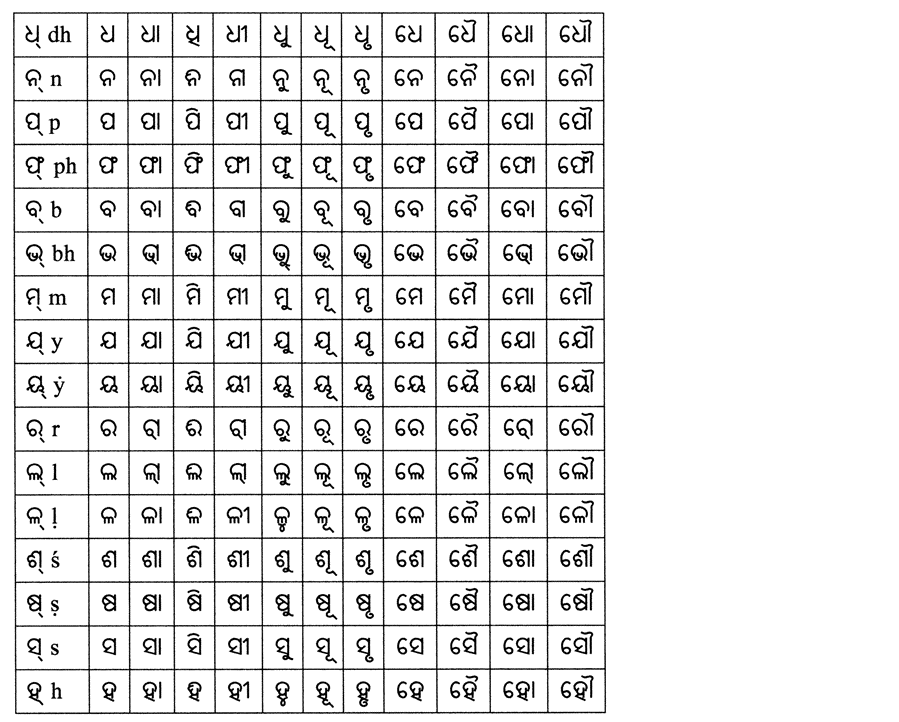Oriya script
| Oriya | ||
|---|---|---|
 ka in Oriya |

|
|
| Font | Abugida | |
| languages | Oriya | |
| Used in | Odisha | |
| ancestry |
Protosinaitic script → Phoenician script → Aramaic script → Brahmic script → Oriya |
|
| particularities | Belongs to the Indian font family. | |
| Unicode block | U + 0B00-U + 0B7F | |
| ISO 15924 | Orya | |
The Oriya script ( ଉତ୍କଳ ଲିପି Utkala Lipi or ଉତ୍କଳାକ୍ଷର Utkalakshara) is an Abugida that belongs to the North Indian scripts. It is derived from the Brahmi script and is used in India (state Odisha ). The oldest known inscription in this script is from the year 1051 .
The Oriya script is also used to write a number of minority languages in the state of Odisha .
Text example
(Bidhu Bhusan Das Gupta and Bimbadhar Das: Oriya Self-Taught, Calcutta 1967)
Translation (after Das Gupta and Das):
An old man called Chandrasekhar lived in a village. He had two sons. The older was called Shashibhusan, the younger Charubhusan. Charubhusan lost his father when he was only a year and a half old. So his mother loved him very much. His older brother was seven or eight years older than him. So while Shashibhusan went to school, Charubhusan only spent the time playing.
"Oṛiyā is encumbered with the drawback of an excessively awkward and cumbrous written character. ... At first glance, an Oṛiyā book seems to be all curves, and it takes a second look to notice that there is something inside each. "
particularities
The Oriya script is an Abugida . It belongs to the Indian group of writings . For more information on the typology of Indian scripts and the alphabetical order, see Indian script group .
Oriya alphabet
Among the Oriya-character Latin is transliteration according to ISO 15919 and in brackets the phonetic IPA - transcription specified.
Vowels
Consonants
Virama and vowel diacritics
As in other Abugidas , the Oriya script consonant signs have an inherent vowel. It is transliterated as 〈a〉and pronounced [ɔ]. His absence is marked graphically with Hasanta (Virama):
For the other vowels are Vokaldiakritika used:
The vowel diacritics can merge more or less strongly with the consonant signs. Such ligatures are used less often in modern prints .
Consonant ligatures
The Oriya script forms two types of consonant ligatures. The North Indian type is formed by fusing two or more consonants, analogous to most North Indian scripts such as B. Devanagari . In the South Indian type, the consonants are arranged one above the other, as in the scripts for Kannada and Telugu (and sometimes also Malayalam ). The following table shows the most common ligatures. (Their number can vary from font to font.)
Special forms for 〈ẏa〉 and 〈ra〉
〈Ẏa〉 and 〈ra〉 as components of a ligature are given special forms. As the last link, they become ![]() and
and ![]() .
.
〈Ra〉 at the beginning of a ligature is ![]() shifted to ("Repha") and, as in other Indian scripts, to the end of the writing syllable (see under Indian writing circle ).
shifted to ("Repha") and, as in other Indian scripts, to the end of the writing syllable (see under Indian writing circle ).
Ambiguous characters / possible confusion
Many Oriya signs can easily be confused with one another. This increases the difficulty in learning the script.
To reduce the likelihood of confusion, in some cases a small slash is added as a diacritic at the lower right end of the character . It is similar to Hasanta (Virama), but is connected to the letter while Hasanta remains unconnected. If a consonant forms a vowel ligature in which its lower right end is changed, the small slash is shifted to a different position. This also applies to consonant ligatures that contain this slash (see table of consonant ligatures).
Some ligature components and variants of vowel diacritics have varying functions:
Consonants open at the top are given a tick as a variant of the diacritical for i〈 at the bottom:
The same check mark is used in some consonant ligatures to denote 〈t〉 as the first component:
The signed form of 〈ch〉 is also used for 〈th〉:
The signed form of 〈bh〉 also serves as a diacritical for various purposes:
The signed forms of 〈ṇ〉 and 〈tu〉 are almost identical:
The nasal sign 〈ṁ〉 can also be used as a diacritic in another function:
Oriya digits
Comparison of the Oriya script with its neighbors
At first glance, the large number of characters with round shapes suggests that the Oriya script might be more closely related to its southern neighbor Telugu than to its neighbors Bengali in the north and Devanagari in the west. The reason for the round shapes in Oriya and Telugu (and also in Kannada and Malayalam ) is the earlier writing method in which the characters were scratched into a palm leaf. Horizontal lines had to be avoided in order not to damage the sheet.
Thus the horizontal line became an arc over most of the Devanagari and Bengali signs in the Oriya. Therefore, when reading the Oriya script, the distinctive parts of the letters are usually found relatively small under the large arch. If you take this into account, the following tables clearly show a closer relationship with Devanagari and Bengali . However, all the scriptures shown here have the same origin, the Brahmi script .
Vowels
Consonants
Vowel diacritics
The treatment of 〈e〉 〈ai〉 〈o〉 〈au〉 in Oriya is the same as in Bengali , Malayalam , Sinhala , Tamil , Grantha and also in SE Asian scripts such as Burmese , Khmer and Thai , but it differs significantly from Devanagari , Gujarati , Gurmukhi , Kannada , Telugu and Tibetan .
Oriya in Unicode
Unicode encodes the Oriya script in the Oriya Unicode block in the code range U + 0B80 – U + 0B7F.
| 0 | 1 | 2 | 3 | 4th | 5 | 6th | 7th | 8th | 9 | A. | B. | C. | D. | E. | F. | |
|---|---|---|---|---|---|---|---|---|---|---|---|---|---|---|---|---|
| B00 | ଁ | ଂ | ଃ | ଅ | ଆ | ଇ | ଈ | ଉ | ଊ | ଋ | ଌ | ଏ | ||||
| B10 | ଐ | ଓ | ଔ | କ | ଖ | ଗ | ଘ | ଙ | ଚ | ଛ | ଜ | ଝ | ଞ | ଟ | ||
| B20 | ଠ | ଡ | ଢ | ଣ | ତ | ଥ | ଦ | ଧ | ନ | ପ | ଫ | ବ | ଭ | ମ | ଯ | |
| B30 | ର | ଲ | ଳ | ଵ | ଶ | ଷ | ସ | ହ | ଼ | ଽ | ା | ି | ||||
| B40 | ୀ | ୁ | ୂ | ୃ | ୄ | େ | ୈ | ୋ | ୌ | ୍ | ||||||
| B50 | ୕ | ୖ | ୗ | ଡ଼ | ଢ଼ | ୟ | ||||||||||
| B60 | ୠ | ୡ | ୢ | ୣ | ୦ | ୧ | ୨ | ୩ | ୪ | ୫ | ୬ | ୭ | ୮ | ୯ | ||
| B70 | ୰ | ୱ | ୲ | ୳ | ୴ | ୵ | ୶ | ୷ | ||||||||
literature
- Don Matson: Introduction to Oriya. II Oriya Writing; East Lansing (Michigan State University) 1971
- Tripathi Kanjabihari: The Evolution of Oriya Language and Script; Cuttack (Utkal University) 1962
- Elvira Friedrich: Introduction to the Indian Scriptures. Part 2: Gujarati, Gurmukhi, Bengali, Oria . Buske, Hamburg 2002, ISBN 978-3-87548-219-5














